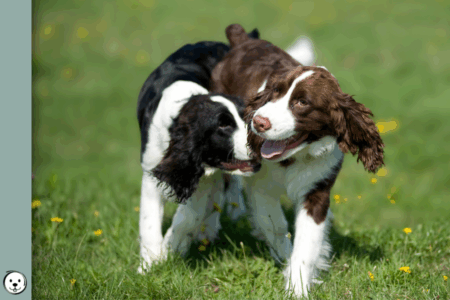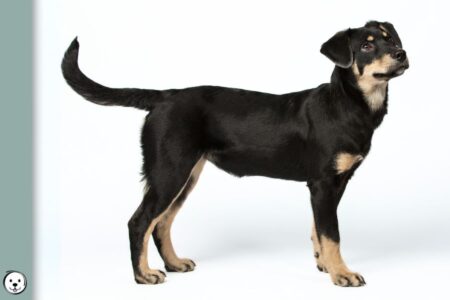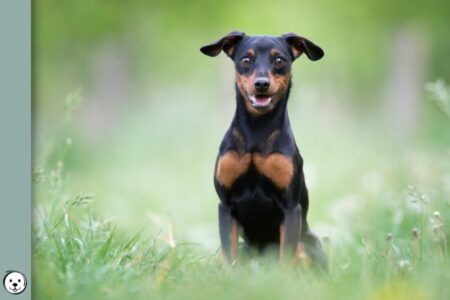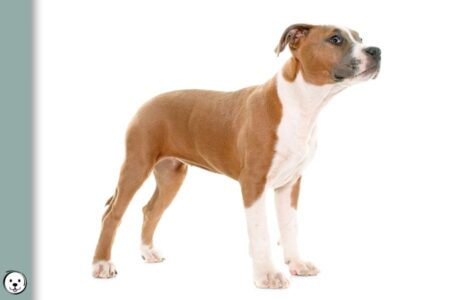The Doberman Pinscher is a short-haired working dog from Germany. They come in a variety of coat colors, although nowadays only American Dobes are officially bred in blue and lilac.
Doberman Color Chart
An overview of Doberman colors and their genetics.
| E/E ky/ky at/at tan point | B/- black eumelanin | b/b brown eumelanin |
| D/- normal eumelanin | 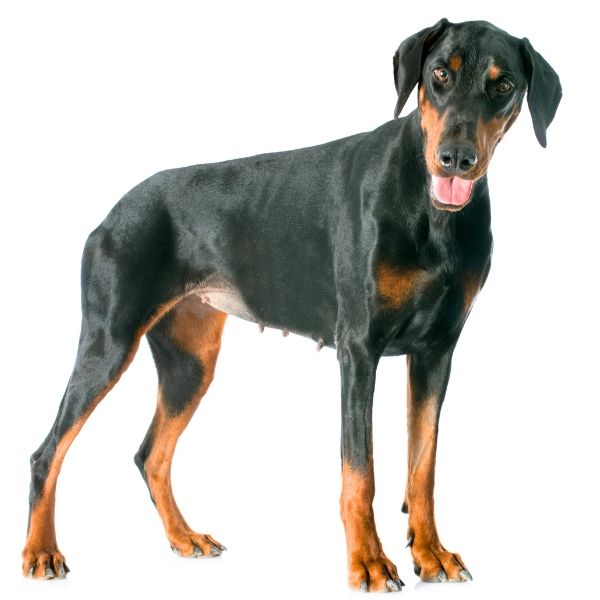 “Black & Rust” black-based tan point | 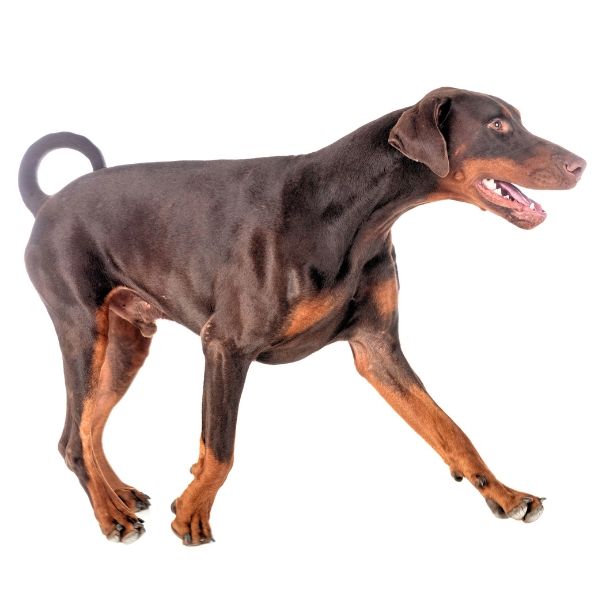 “Red & Rust” brown-based tan point |
| d/d diluted eumelanin |  “Blue & Rust” blue-based tan point | 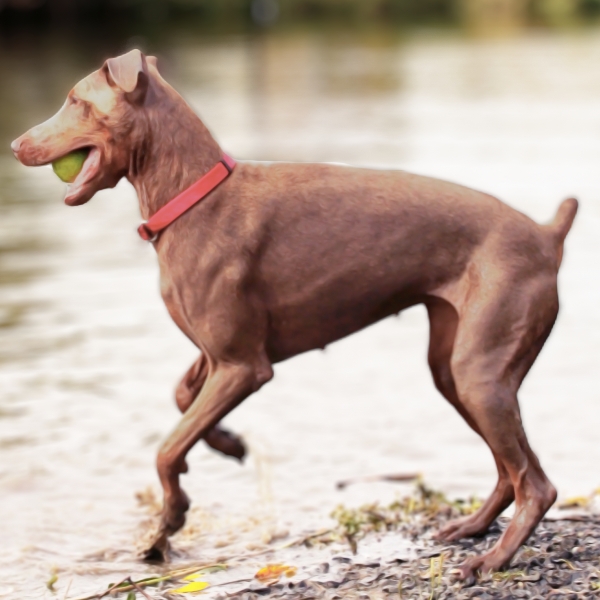 “Fawn & Rust” “Isabella & Rust” lilac-based tan point |
Doberman Coat Colors Overview
The breed standard describes all the different traits an ideal Doberman should have.
This includes its coat texture and color, of course.
However, different kennel clubs each have their own standards. These are usually similar in their general outline but can differ in details such as accepted standard coat colors.
In case of Dobies, the FCI stopped accepting dilute colors (blue and isabella) in 1994.
| AKC | FCI | KC | |
|---|---|---|---|
| Black & Rust Black With Rust Red | ✅ | ✅ | ✅ |
| Red & Rust Brown With Rust Red | ✅ | ✅ | ✅ |
| Blue & Rust Blue With Rust Red | ✅ | – | ✅ |
| Fawn/Isabella & Rust Fawn/Isabella With Rust Red | ✅ | – | ✅ |
Brackets indicate color names that are not mentioned in the breed standard without excluding them.
Standard Dobermann Coat Colors
Let’s have a closer look at the different Doberman color patterns:
Dobes are fixed for a tan point pattern (E/E ky/ky at/at).
This pattern gives a mainly solid coat (eumelanin) with tan markings (phaeomelanin).

Read more about pigment types here.
Their black eumelanin (B/-) can be modified to brown (b/b). Brown eumelanin is called “red” in this breed, meaning a red Doberman is in fact a chocolate brown Doberman.
And both black and brown can be diluted if a dog is d/d. This turns black to blue (diluted black) and brown to lilac (diluted brown), the latter being called “fawn” or “isabella” in Dobies.
“Allowed Colors-Black, red, blue, and fawn (Isabella). “
AKC Breed Standard
“The Dobermann is bred in two colour varieties: black or brown with rust red […]“
FCI Breed Standard
Doberman markings have a reddish rust color.
Their placement is always the same in all dogs with a tan point pattern. However, markings can vary slightly in size and be clear or smutty with more or less defined edges.
Typical face markings are found on the eyebrows, on the cheeks and sides of the muzzle (leaving a dark nose bar on top of the muzzle) extending down to the throat. Body markings include two tan triangles on the chest, tan on the inner thighs, lower legs and paws. And a tan spot under the tail.
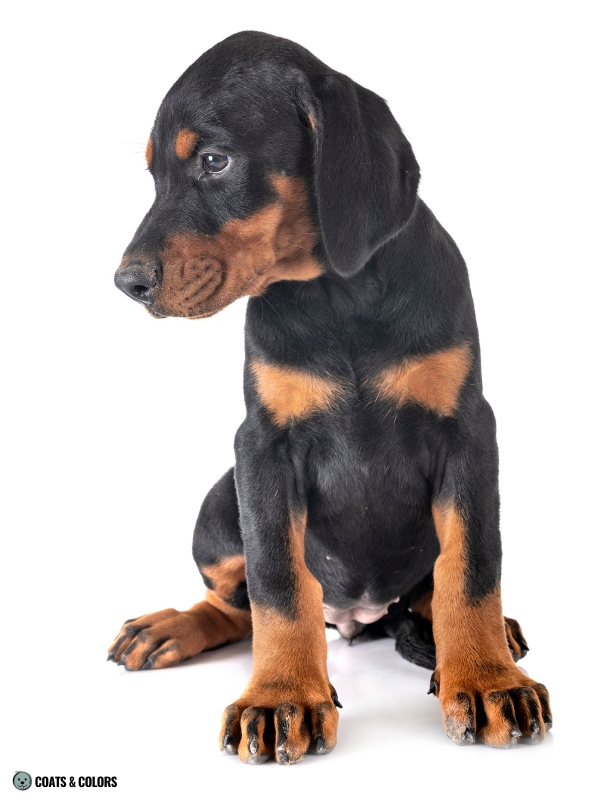
Newborn Doberman puppies can look almost black (or brown, blue, isabella) before the first hints of their tan pigment become visible.



“Rust, sharply defined, appearing above each eye and on muzzle, throat and forechest, on all legs and feet, and below tail.”
AKC Breed Standard
“[…] clearly defined and clear markings (tan markings). Tan markings are on the muzzle as a spot on the cheeks and the top of the eyebrow; on the throat; two spots on the forechest; on the metacarpus, metatarsus and feet; on the inner side of the hind thigh; on the forearms and under the tail.”
FCI Breed Standard
Black & Rust Doberman

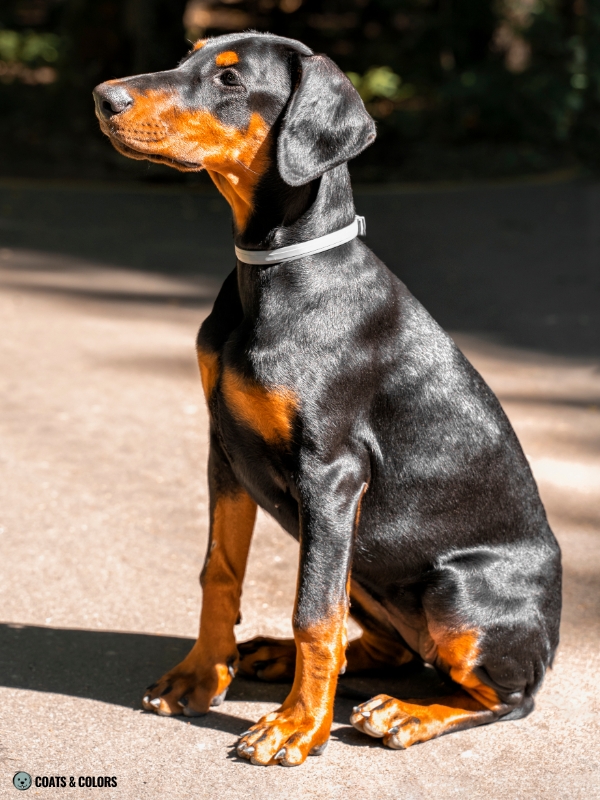

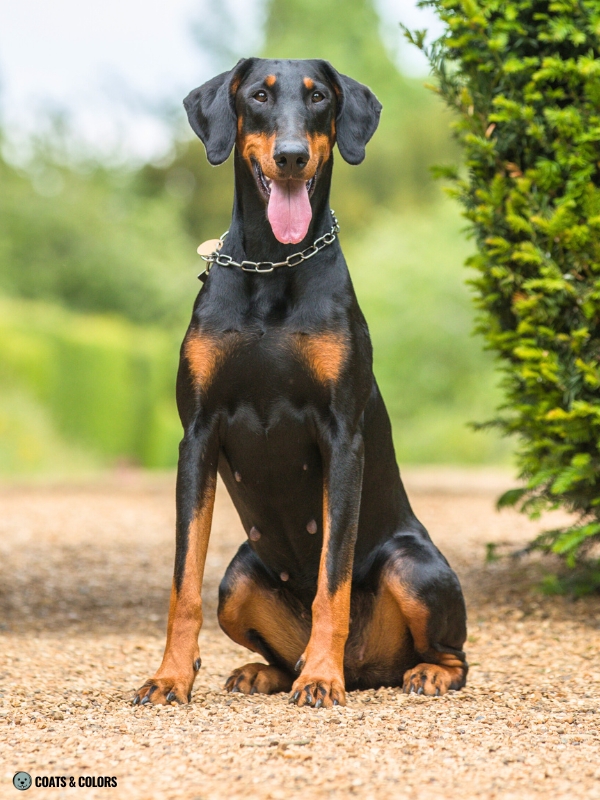
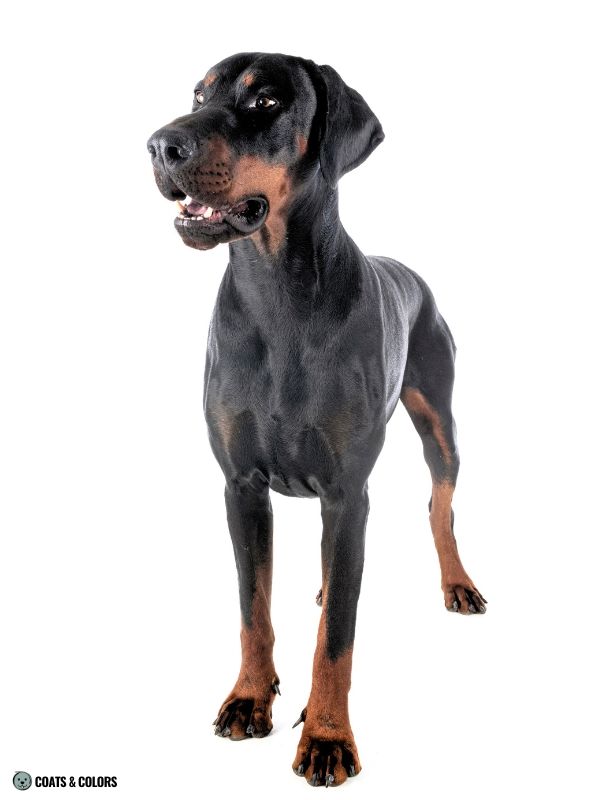

Black and rust is a Dobie breed term for a black-based tan point pattern.
This pattern is often called “black & tan“. The FCI calls it “black with rust red“.
These dogs have a solid black coat with tan markings on their face, chest, legs, and under their tail. The color of their markings is affected by intensity genes.
And Dobermans are bred for crisp reddish markings.
Red & Rust Doberman

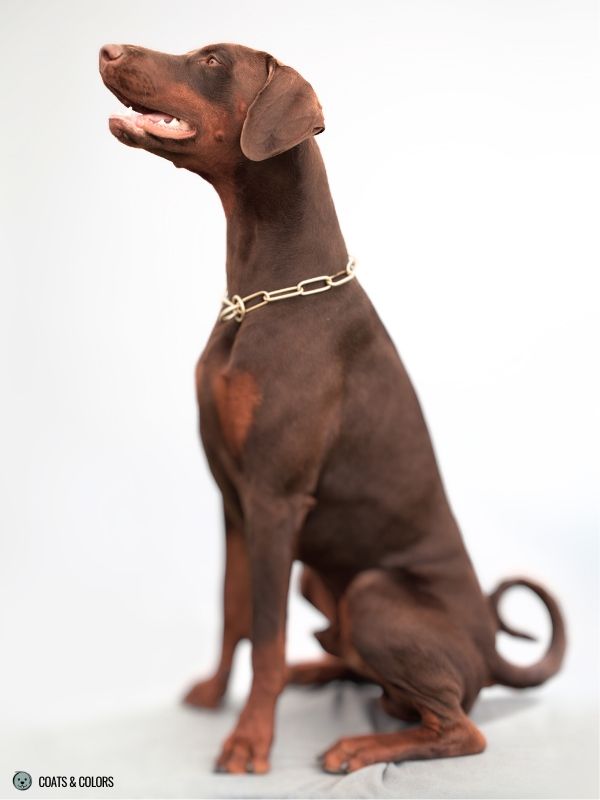



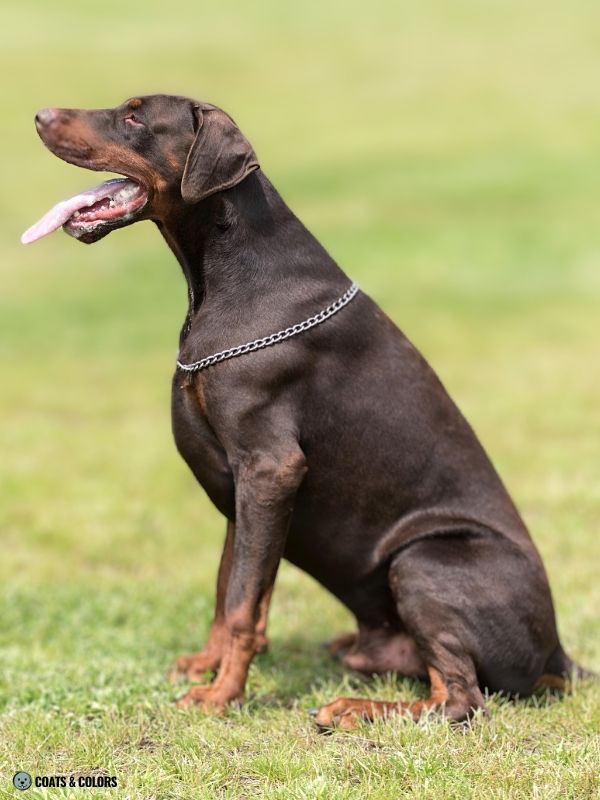
The red and rust color refers to a chocolate and tan Doberman aka brown-based tan point.
Brown eumelanin can vary from light brown to dark brown.
They have a tan point pattern (E/E ky/ky at/at) but with brown eumelanin (b/b D/-).
The brown pigment happens due to being homozygous recessive (b/b) at the B locus.
This causes a dog to lose the ability to make black eumelanin. Instead, all of its eumelanin is modified to a chocolate or liver brown color. Including its toe nails, nose and skin pigment.
In AKC Dobermans, the chocolate color is called “red“. And the tan pigment is called “rust“.
The FCI and KC call the same color “brown with rust red“.
Doberman Pischers with brown eumelanin also tend to have very light greenish puppy eyes and dark yellow to light brown or amber eyes as adults.
“Red is really reddish brown, and the most desirable shade is the rich brown with a reddish glow.”
Doberman Pinscher Club of America – Illustrated Standard
Blue & Rust Doberman
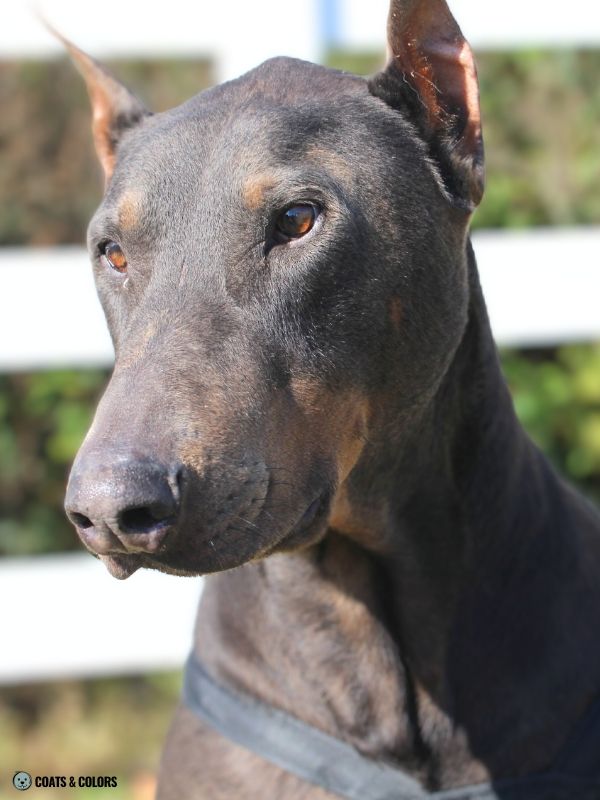
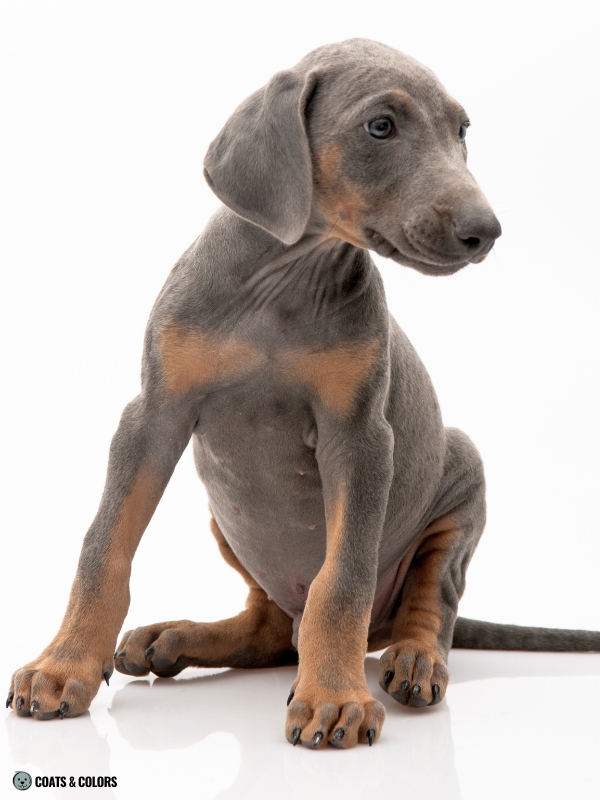
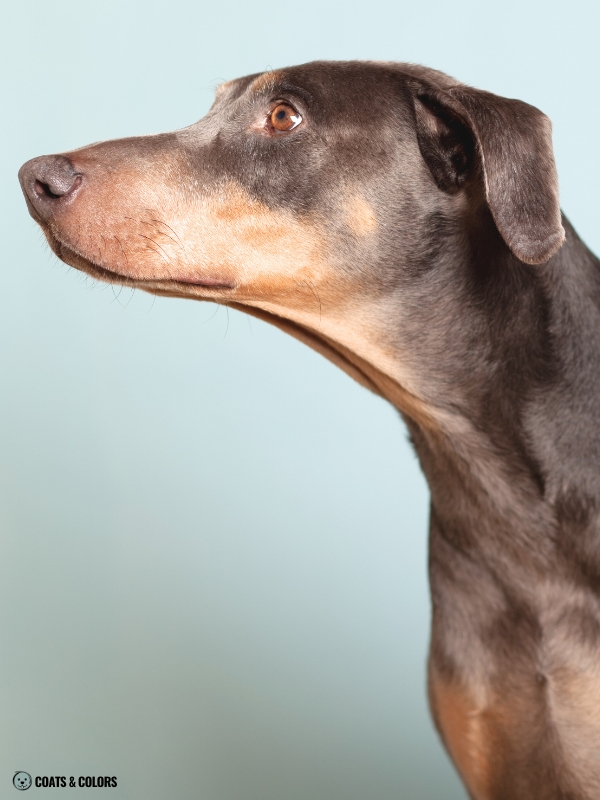
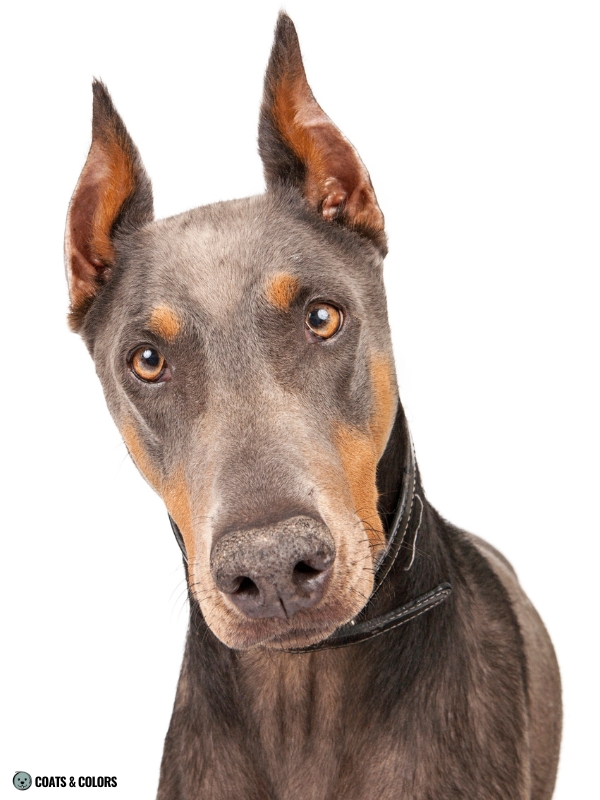

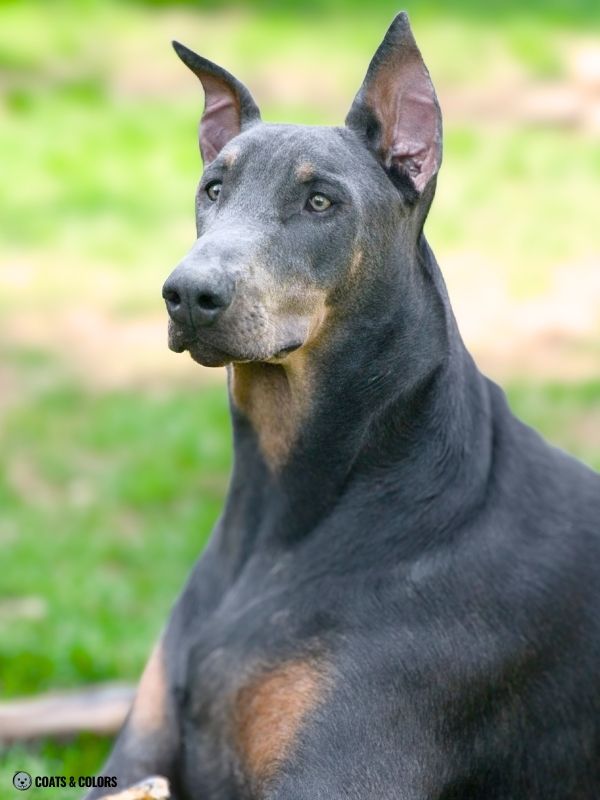
This is a breed term for a blue-based tan point pattern.
A Doberman with diluted black pigment (B/- d/d) will express silvery gray eumelanin.
Blue pigment can vary from a dark slate to a light silver color.
The AKC call these blue and tan Dobermans “blue and rust“. The British Kennel Club calls them “blue with rust red“. Some just call them “gray” or “silver“.
The FCI does not accept blue and tan Dobermanns (anymore), they banned diluted colors a while ago.
“Blue (a dilution of black) is a bluish gray color. It is actually a medium-to-dark shade of gray and ideally has a definitely bluish cast.”
Doberman Pinscher Club of America – Illustrated Standard
Fawn & Rust Doberman
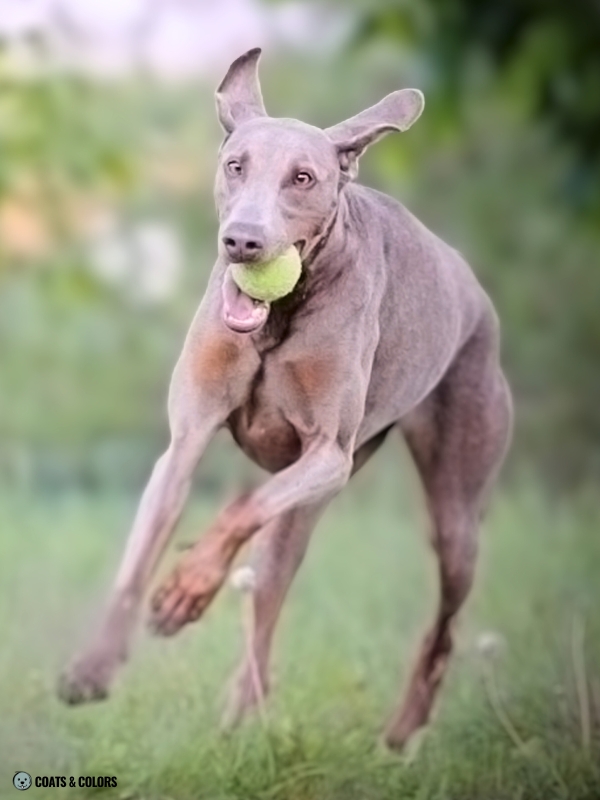


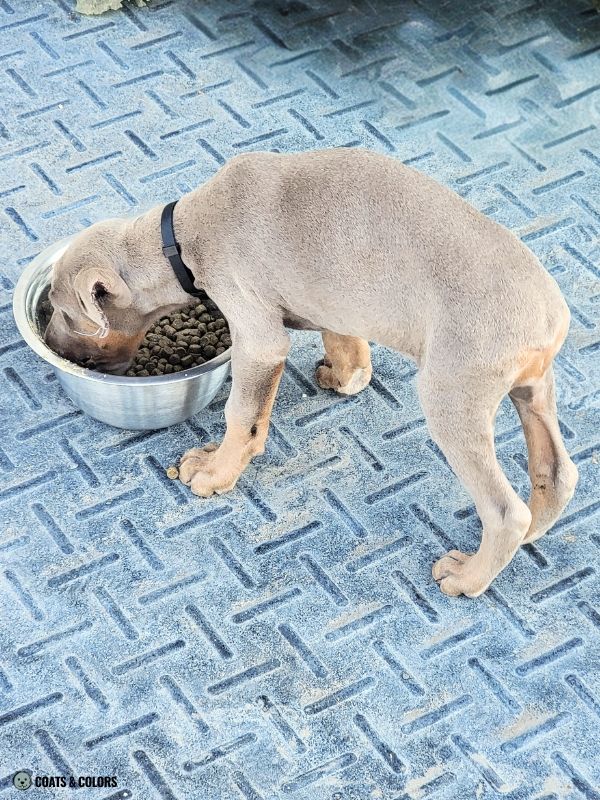

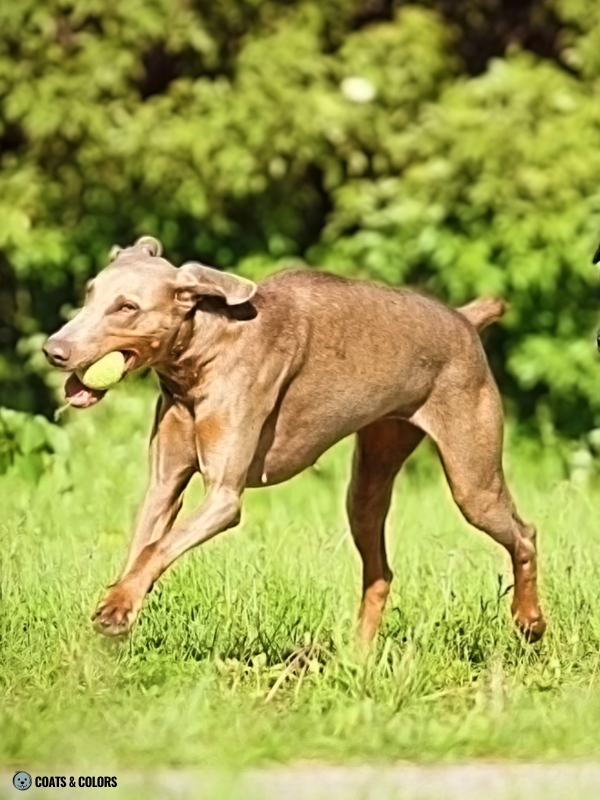
Dobermans with a lilac-based tan point pattern have both brown eumelanin (b/b) and color dilution (d/d). They express diluted brown eumelanin.
This gives a light-colored Doberman with a silvery beige color and rust markings.
Lilac pigment can vary from a dark taupe to a pale beige color.
The Doberman Pinscher Club of America describes it as “about the color range of camel’s hair“.
In color genetics, we call this mousy gray or taupe color “lilac“. The breed terms in Dobermans are “fawn” or “isabella“. Keep in mind that calling it “fawn” can be misleading since many other breeds use the “fawn” term for a clear sable pattern (phaeomelanin) and not for lilac (eumelanin).
“Fawn (also referred to as Isabella, a dilution of red) is a silvery beige color.”
Doberman Pinscher Club of America – Illustrated Standard
CDA In Dobermans
The Doberman Pinscher Club of America admits that “blues and fawns also have a higher incidence of coat and skin problems“. They claim that “the hair itself is softer and has a difficult time coming through the follicle and emerging through the skin“.
However, it it actually not the diluted color itself that cause health problems.
What happens is that diluted colors predispose a dog to color dilution alopecia. CDA is a skin condition that can only manifest in portions of the coat that grow hairs with diluted eumelanin.
See, diluted colors happen when pigment granules clump together. And CDA can then affect these areas and cause anything from mild hair loss to more severe skin problems.
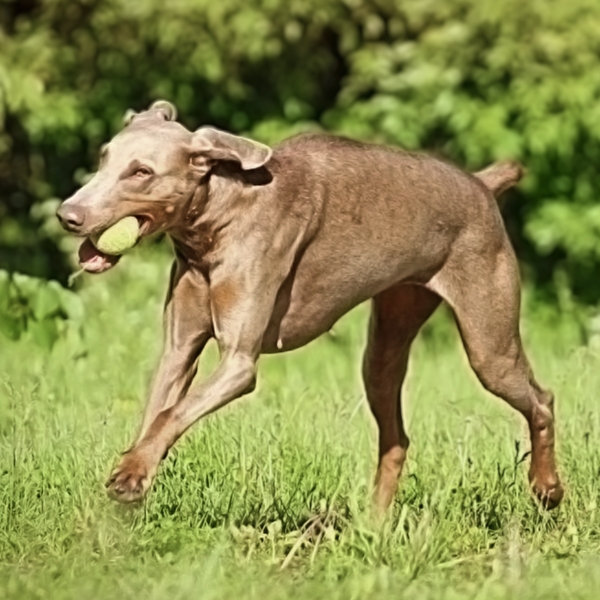
The FCI stopped breeding dilute colors altogether because so many blue and isabella dogs were affected by “Blue Doberman Syndrome“.
Dobies with normal pigment will not be affected.
The problem is that these dogs with non-diluted black or brown pigment can still have and pass on whatever causes CDA (at least that’s the best explanation so far, CDA is not testable).
Any offspring of “CDA carriers” that actually has diluted coat is then at risk to have dilution alopecia. This makes it hard to breed away from CDA. YOu can only see it in blue and fawn dogs.
A common myth states that breeding dilute to dilute will make the problem worse.
This is nonsense. The fastest way to breed away from CDA is actually to do the opposite. To only breed dilute to dilute so you can spot affected dogs immediately and select away from them.
Just look at Weimaraners (the whole breed is fixed for diluted brown). They don’t have CDA problems anymore because in an all-dilute breed it was easy to breed away from problematic lines.
Doberman Coat Color Genetics
The color alleles that occur in purebred Dobermans:
| E-LOCUS | Em = melanistic mask E = normal pattern e = recessive red |
| K-LOCUS | ky = wild type |
| A-LOCUS | at = tan points |
| INTENSITY | tan rust red |
| B-LOCUS | B = black eumelanin b = brown eumelanin |
| D-LOCUS | D = normal eumelanin d = diluted eumelanin |
| S-LOCUS | S = solid sP = white spotting |
| M-LOCUS | m = non-merle |
The Doberman Pattern
The A locus, K locus and E locus control all basic pigment distribution patterns.
These genes tell pigment cells when and where to make either eumelanin or phaeomelanin.
And Dobes all have the same pattern, so this is easy.
A Locus
Dobermanns are fixed for tan points (at/at) which they call rust markings.
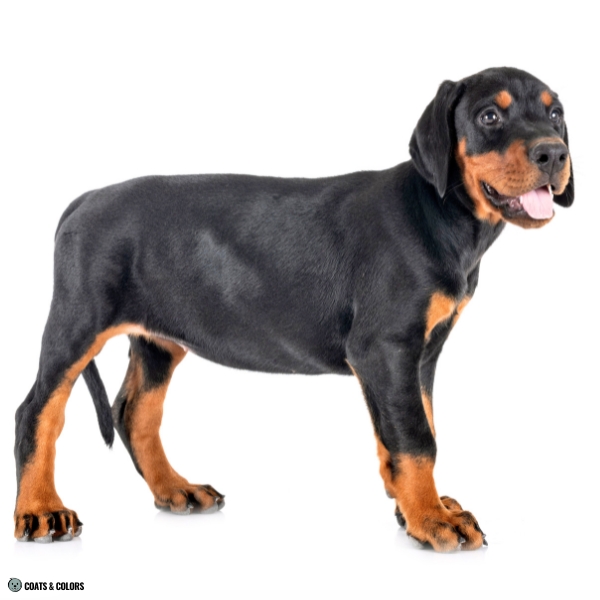
However, there is some natural variation to this pattern.
Markings can slightly vary in size and they can be crisp or smutty. Some dogs are very dark with small sooty rust markings to the point where they have no visible chest markings.
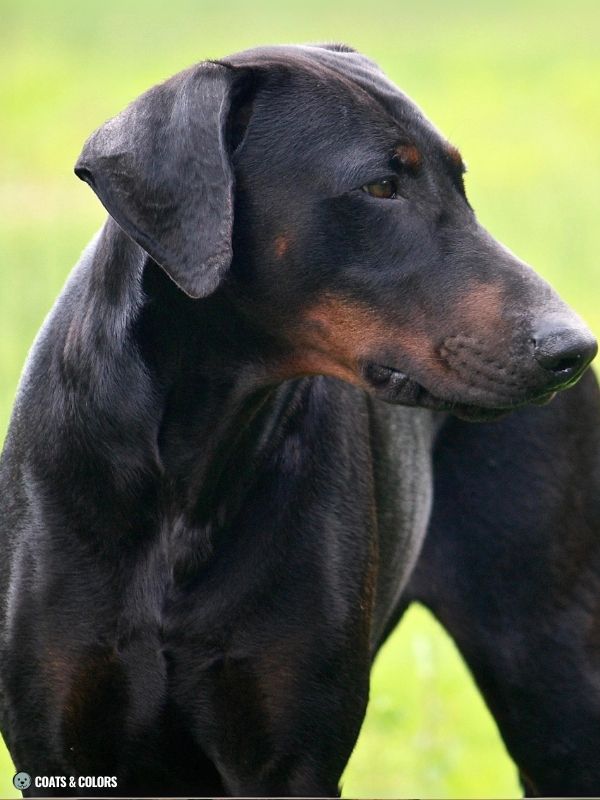
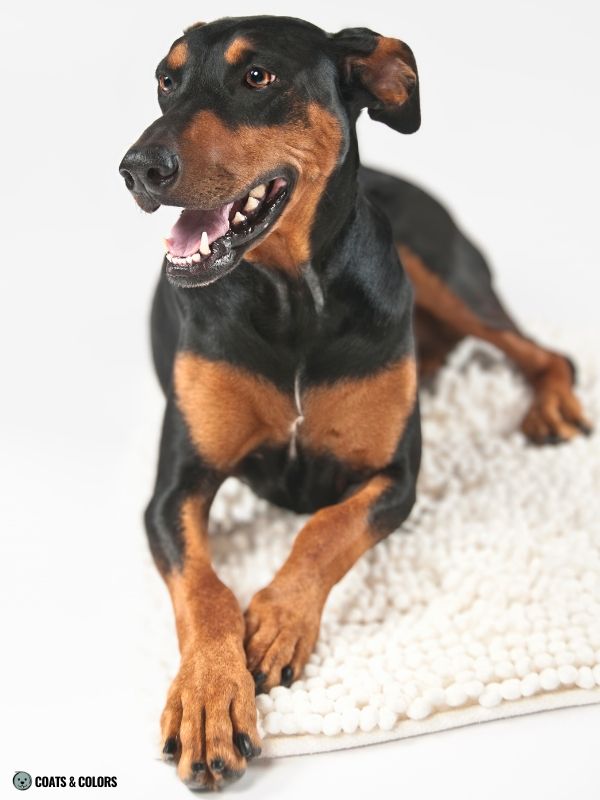
Many Dobermans have some toe pencilling.
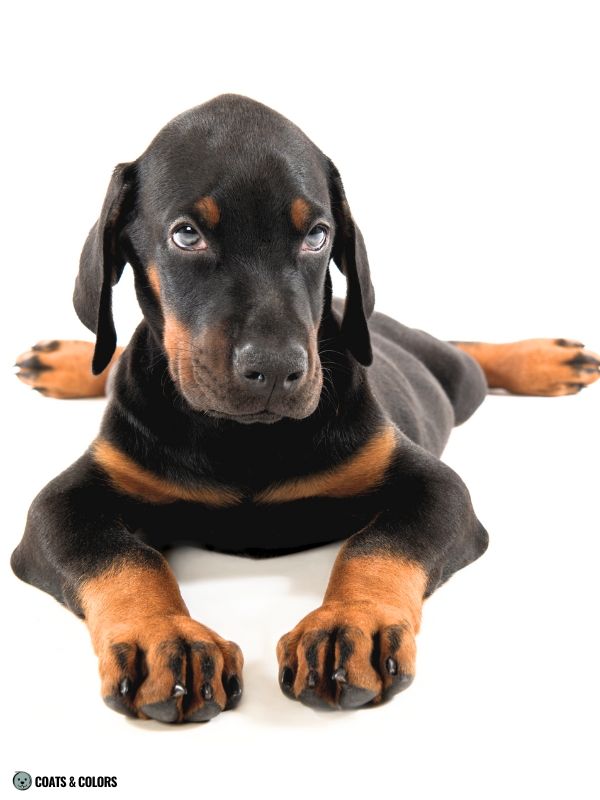
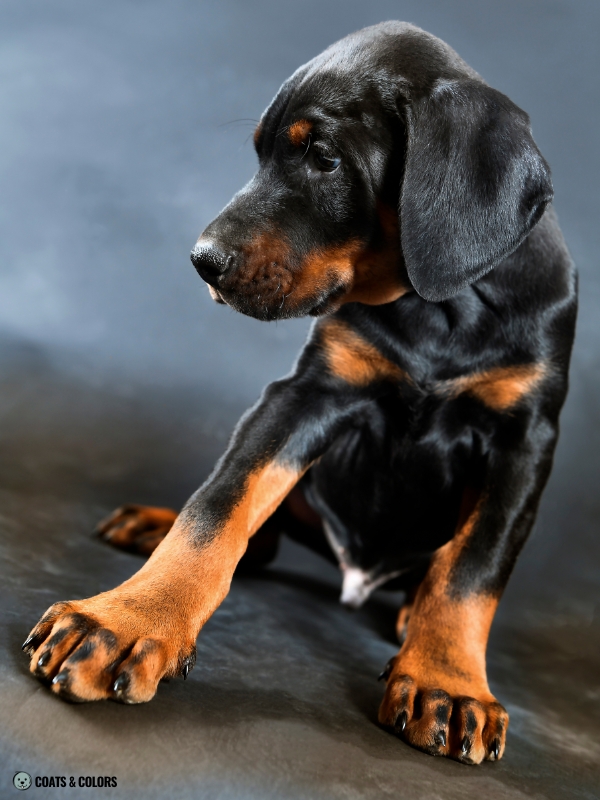
The tan color can vary from pale cream to deep red. It’s also normal to see some pale undercoat, pale hair roots or tan hairs intermingled in black areas.
However, Dobes don’t have real undercoat. And they are bred for solid black in their black areas (or brown, blue, or isabella, respectively) with very defined markings of a rich rust to red color.
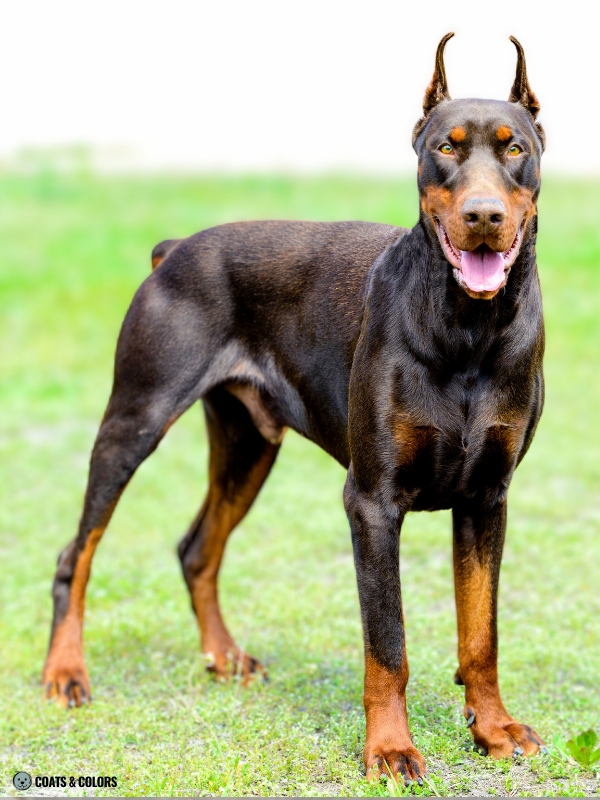
“Faults: […] smudged markings […]“
FCI Breed Standard
“Sharply defined markings are preferable, as they enhance the characteristic look of the Doberman. The markings on the chest should be two small triangles, as opposed to a large unbroken banner.”
“Deviations to the standard include: large splashy markings, light-colored markings, lack of markings, indistinct markings (melanism), markings that bleed into the solid color […]“
Doberman Pinscher Club of America – Illustrated Standard
K Locus
Only dogs with a homozygous wild type genotype (ky/ky) can express their A locus pattern.
E Locus
Dobes are supposed to have crisp face masking. They should be E/E.
However, some dogs have a melanistic mask (Em/-) which may cover some of their muzzle in black (or any modified eumelanin color, e.g. blue dogs have a blue mask).
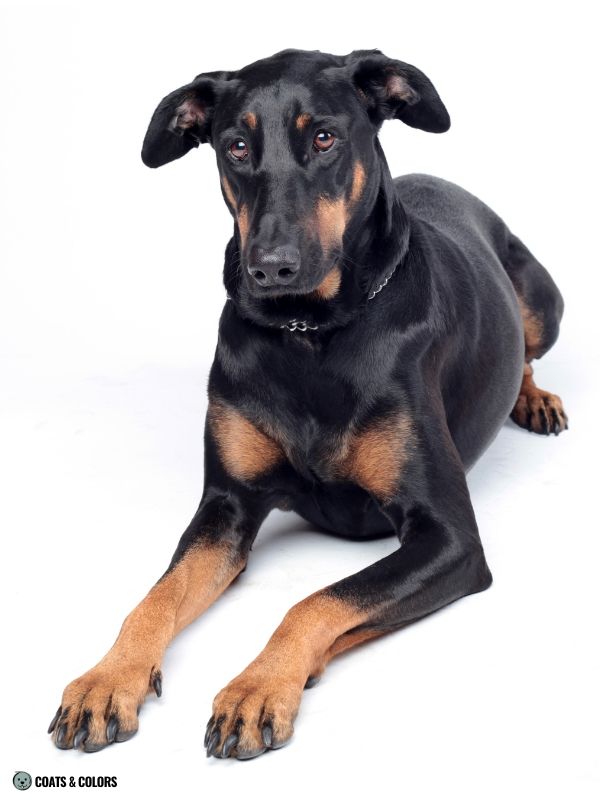
A mask are pretty obvious on black dogs but a smallish mask may go unnoticed on brown or diluted colors due to the low contrast of these colors against the reddish hue of the tan markings.
“Faults: […] mask too dark; big black spot on the legs; chest markings hardly visible or too large;”
FCI Breed Standard
Eumelanin Colors
Dobermans can have black (B/-) or brown eumelanin (b/b).
And AKC and KC Dobes can come in diluted versions of these colors (d/d).
This will turn black to blue (B/- d/d) and brown to isabella (b/b d/d).
The color of a dog’s eumelanin will also affect ist nose color, skin pigmentation, or toe nails.
“[…] Black, red, blue, and fawn (Isabella).“
AKC Breed Standard
“[…] two colour varieties: black or brown with rust red […]“
FCI Breed Standard
Phaeomelanin Intensity
The phaeomelanin intensity in Dobermans is supposed to be a deep red color.
Pale yellow markings are not desired.
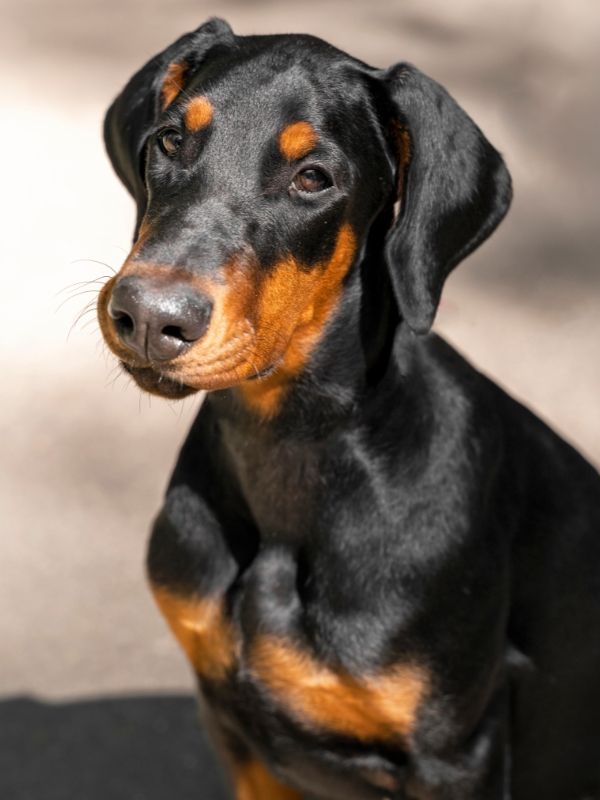
Dilution typically should not affect the rust pigment (phaeomelanin). However, quite some dogs with blue (or isabella) colors also show paler than expected tan markings.
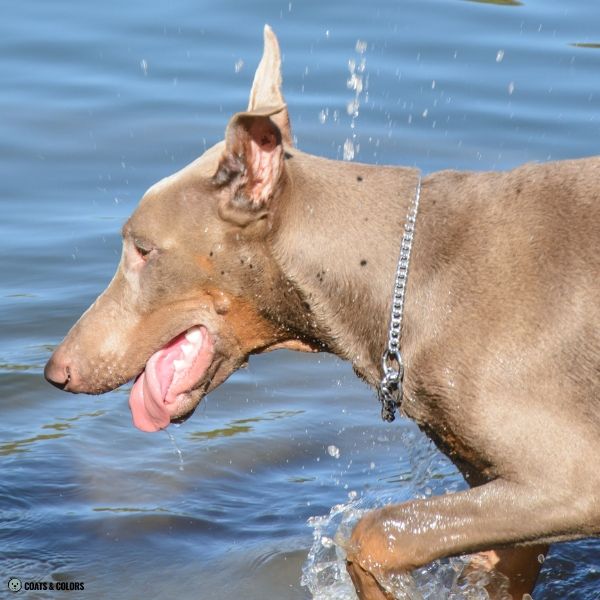
“[…] Markings-Rust […]”
AKC Breed Standard
“The desired color of markings is a deep rust-red but it may be somewhat lighter or darker.”
Doberman Pinscher Club – Illustrated Standard
“[…] rust red, clearly defined and clear markings […]”
“Faults: […] Tan-markings too light […]”
FCI Breed Standard
White Spotting
The FCI and KC do not tolerate white markings.
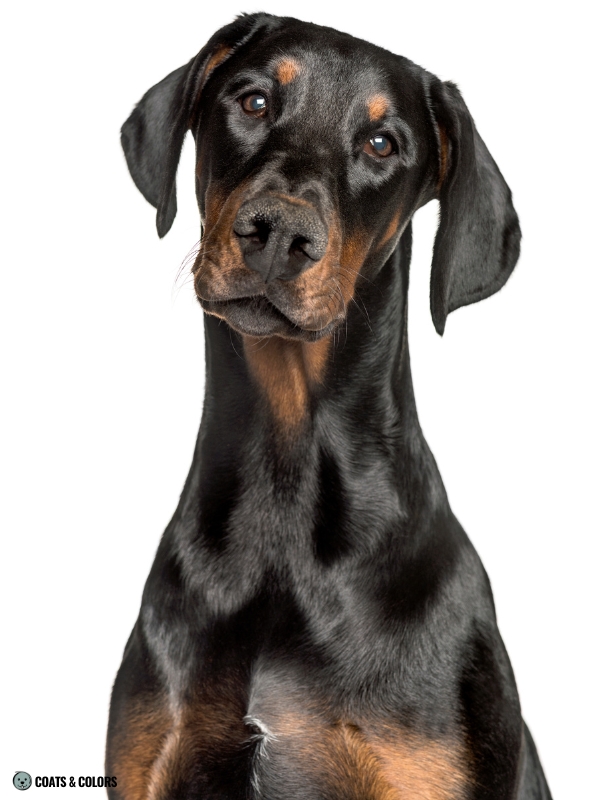

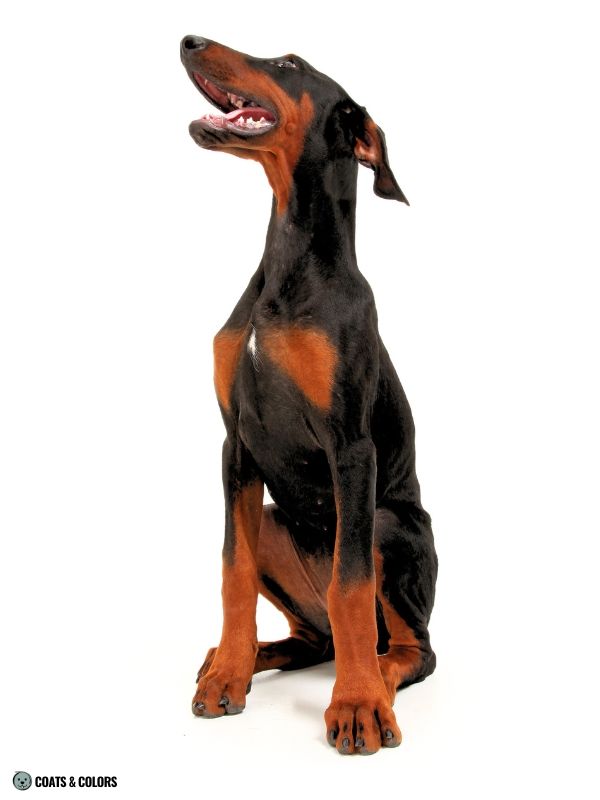
The AKC says a very small white chest patch due to residual white is ok.
There are some Dobes that test positive for a piebald variant (sP) while having no actual white. This is because the test for white spotting is a linkage test and not entirely accurate across breeds.
“White patch on chest, not exceeding ½ square inch, permissible.”
AKC Breed Standard
“Deviations to the standard include: […] white chest patches larger than 1/2-inch square or white elsewhere on the dog.”
Doberman Pinscher Club – Illustrated Standard
“Disqualifying Faults: […] White spots.”
FCI Breed Standard
Coat Color Genotypes
Dobermans are all tan point, they share the same pattern.The main difference in phenotypes is due to different eumelanin colors. So it’s not that hard to translate Dobie breed terms into genetic terms:
| Color Term | Pattern |
|---|---|
| Black & Rust Black With Rust Red | B/- D/- E/E ky/ky at/at black-based tan point |
| Red & Rust Brown With Rust Red | b/b D/- E/E ky/ky at/at brown-based tan point |
| Blue & Rust Blue With Rust Red | B/- d/d E/E ky/ky at/at blue-based tan point |
| Fawn & Rust Fawn With Rust Red Isabella & Rust Isabella With Rust Red | b/b d/d E/E ky/ky at/at lilac-based tan point |
Doberman Eye Colors
Dobermans can have different eumelanin colors (black, brown, blue, lilac).
They are bred for darker eye colors with brown eyes being preferred.
However, pigment color and the amount of pigment in the iris is what gives a range of possible eye colors. Overall, dogs with lighter pigment tend to have lighter eyes.
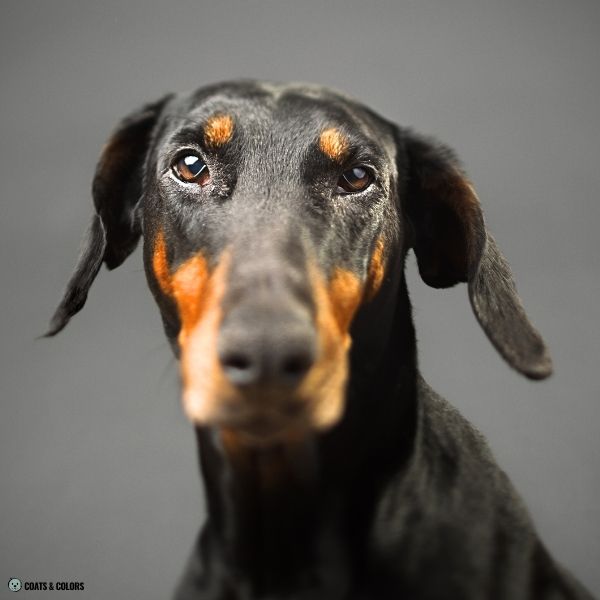
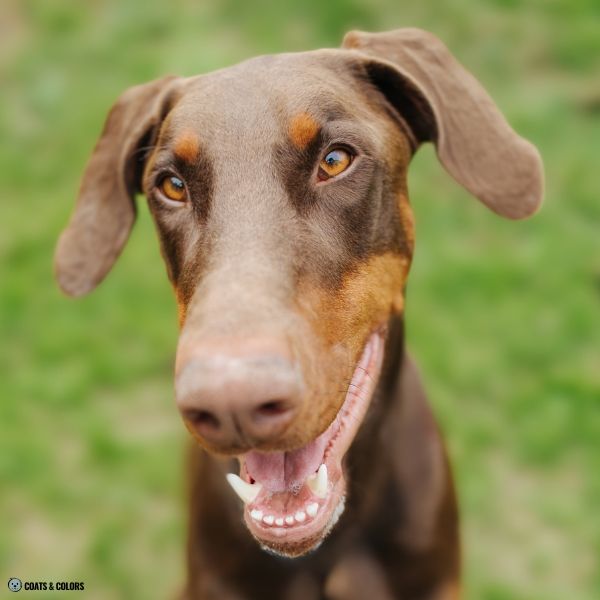
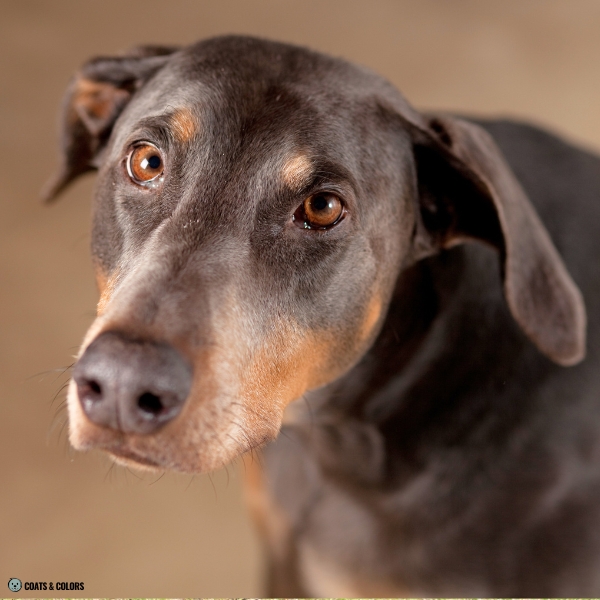
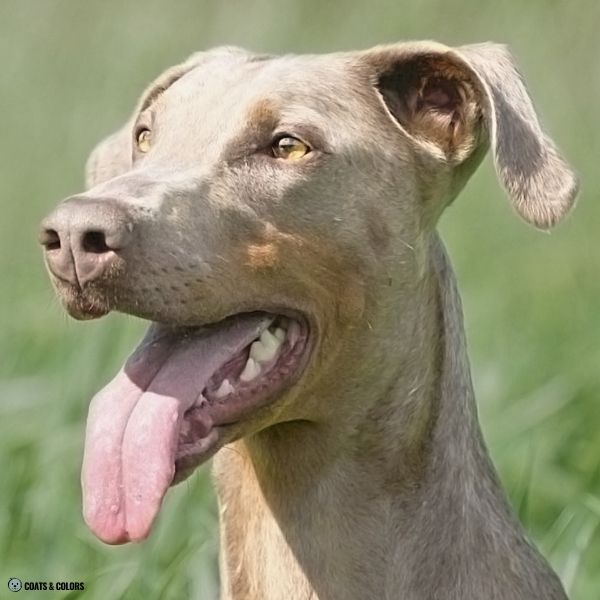
This is especially pronounced in not yet fully pigmented puppy eyes where brown or diluted dogs often show very pale greenish or light yellow colors. It can take months for their eyes to darken.
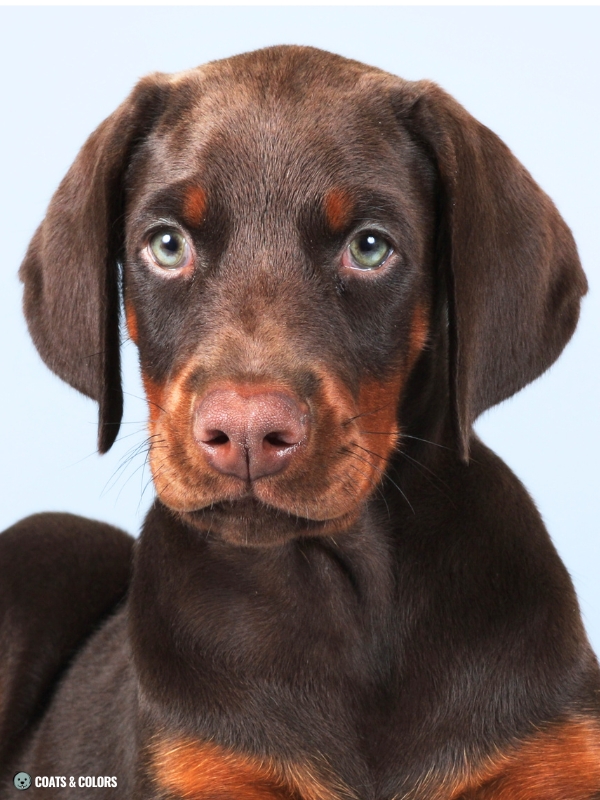
“Iris, of uniform color, ranging from medium to darkest brown in black dogs; in reds, blues, and fawns the color of the iris blends with that of the markings, the darkest shade being preferable in every case.”
AKC Breed Standard
“Disqualifying Faults: […] Yellow eyes (bird of prey eye); different coloured eyes.”
FCI Breed Standard
Doberman Nose Colors
Dogs with black pigment have a black nose, dogs with brown pigment are red-nosed. All Dobermans with diluted black will have a gray nose. And fawn Dobermans have taupe-colored nose.

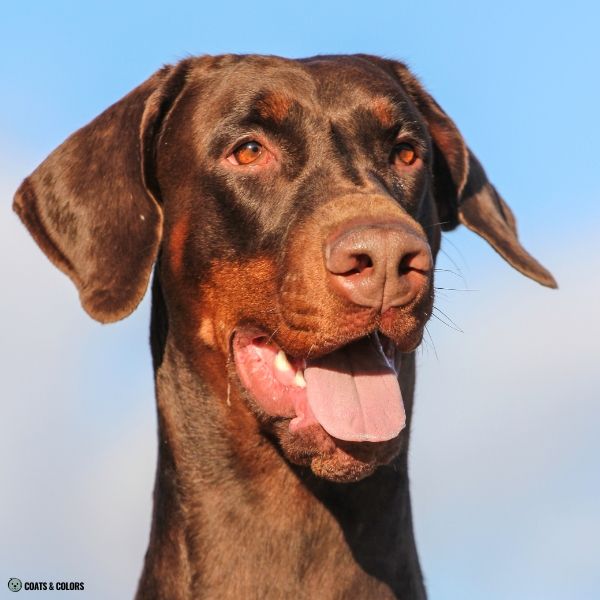
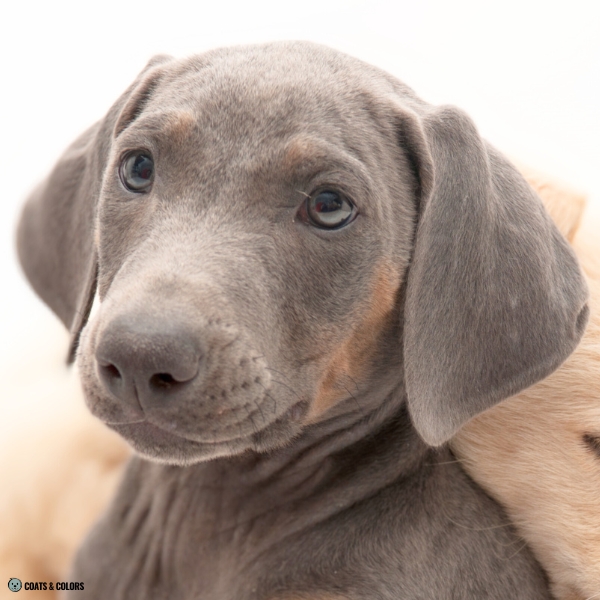

“Nose solid black on black dogs, dark brown on red ones, dark gray on blue ones, dark tan on fawns.”
AKC Breed Standard
“Black – in black dogs; in brown dogs, corresponding lighter shades.”
FCI Breed Standard
Doberman Mismarks and Fancy Colors
This is one of those breeds where a variety of “rare Doberman colors” are heavily marketed by backyard breeders. The most common ones are melanistic or solid black dogs as well as white or albino dogs.
However, a color is only rare if it happens by accident. Not if someone versed in color genetics mass-produces them on purpose to make a quick buck on the internet.
“Disqualifying Fault – Dogs not of an allowed color.“
AKC Breed Standard
Most decent breeders avoid off-colors. But in this breed, many new “rare” traits have been achieved by cross-breeding and introducing new colors into the gene pool of pet Dobermans.
Merle Doberman
Merle is a dominant trait and Dobes don’t come in merle!
However, it is one of the most fanciest colors to advertise… So of course people have “borrowed” it by mixing in some merle breed (such as Great Danes or Beaucerons).
Tan Doberman
To get a solid blonde Doberman Pinscher, breeders have introduced the recessive red allele. Dogs with a homozygous recessive (e/e) genotype can not produce eumelanin in their coat.
This leaves them with a solid tan coat which can vary in intensity from cream to pale blonde to rust to clear red (red as in phaeomelanin). The only visible eumelanin is found in their nose and skin color which can have all the colors (recessive red can be black-, brown-, blue, or lilac-based).
Another way to get a predominantly yellow dog is to introduce clear sable (E/E ky/ky Ay/-) from another breed. These dogs are still patterned just with very little eumelanin in their adult coat.
Brindle Doberman
Purebred Dobermans express a normal tan point pattern. They are all ky/ky.
By introducing a dominant brindle allele (kbr/-), breeders can produce dogs with brindle points.
Eumelanin striping will only be visible against a tan background. On a black and tan dog, the black stripes will only visible in a dog’s points. Only a sable Doberman can express full body brindle.
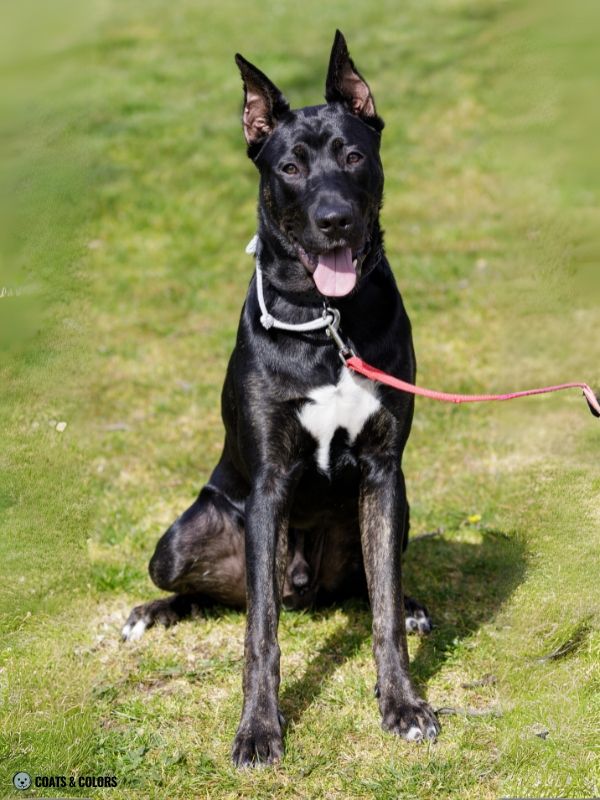
Black Doberman
All solid black Dobermans seem to ahve a dominant black pattern (E/E KB/-).
This is the top dominant allele at the K locus. It forces all pigment cells to produce only eumelanin. And a black and tan dog that can not make tan is … solid black.
Breeders call these full black Dobermans “melanistic“.
Interestingly, none of them are really jet black, most seem to produce ghost tan markings (a trait we call seal makes their A locus pattern bleed through).
Brown Doberman
A dominant black Doberman with black modified to brown (b/b D/-) will have a solid brown coat. These all-brown Dobermans are also called “melanistic red” because red means brown in Dobie terms.

Blue Doberman
You already guessed it, a melanistic blue Doberman is just a solid black dog with diluted black eumelanin (B/- d/d). This gives a solid gray color without tan markings.
Lilac Doberman
If you take a lilac-based Doberman and make him dominant solid (KB), you get a solid isabella dog.
Tri-Color Doberman
By introducing white markings (piebald or whitehead) breeders can produce a tan point pattern with moderate to large white markings. This combination is commonly called tricolor.
Dogs can be black tri, brown tri, blue tri, or lilac tri.
White Doberman
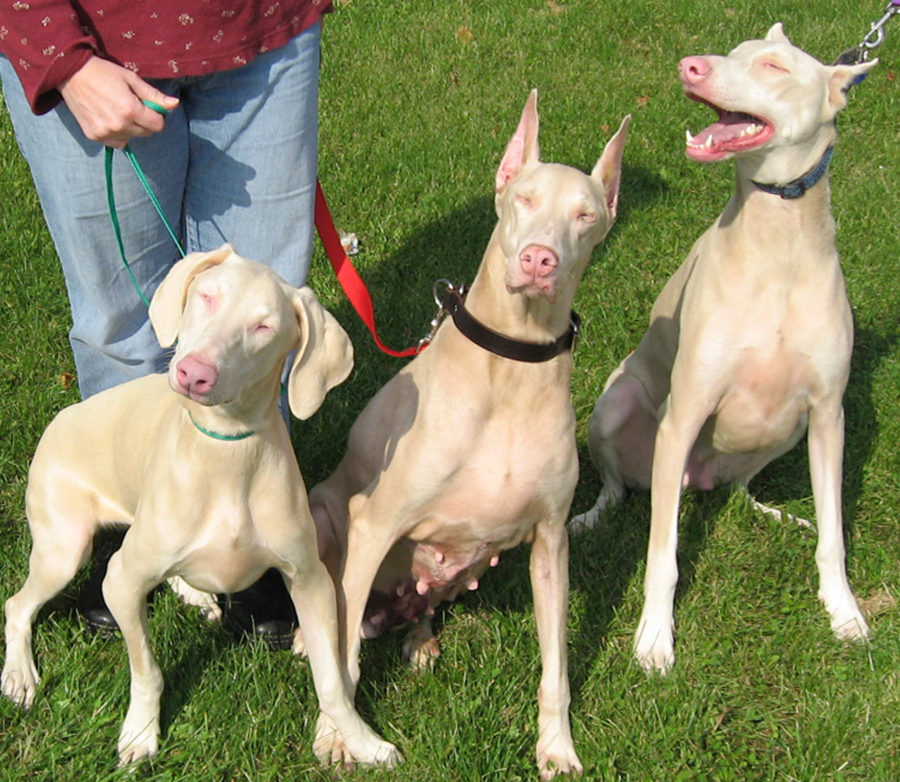
All white Dobermans have a form of oculocutaneous albinism (OCA4) that turns their black-based hairs (black, brown, blue, or lilac) to a cream or very pale sandy color and their rust hairs to white.
Albinism is caused by a lack of pigmentation. But in many types of albinism, not all the pigment gets removed. Most white albino Dobermans are actually “cream with white points“.
They typically have very light blue eyes (which hints at residual pigment) instead of red eyes.
The first albino Doberman is said to be “Padula’s Queen Sheba” born in 1976.
Her novelty color quickly gained attention and was produced in large quantities by extensive line breeding of this dog and her offspring for the recessive mutant allele.
All purebred albino Dobermans descend directly from Sheba.
This is a controversial color because albinism is not just a mismark.
Albinsim is also associated with health issues from skin issues to light sensitivity. And the inbreeding used to produce white Dobes at a large scale is the last thing this breed needed.
Many Dobes today have white ancestry. Many reputable breeders use genetic testing for the defective gene to eliminate albinism in the Doberman Pinscher.
The AKC lists white as an alternate color. Since 1982, white Dobes can not be shown in conformation.
“If there is any white ancestry in a Dobermann’s pedigree, any progeny will be registered with (WHITE ANCESTRY) at the end of the selected colour.“
Kennel Club
Doberman Coat Types
Dobies are short-haired with a glossy dense layer of guard hairs.
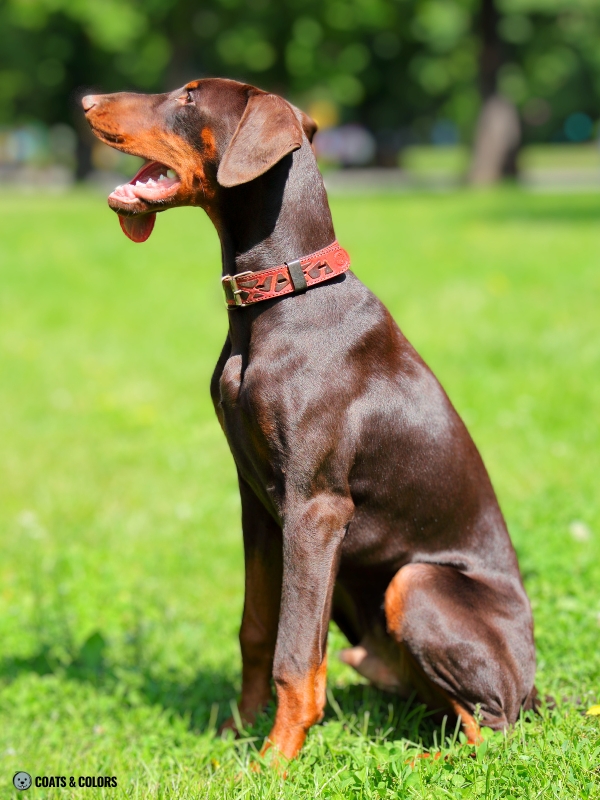
“Smooth-haired, short, hard, thick and close lying. Invisible gray undercoat on neck permissible.”
AKC Breed Standard
“The hair is short, hard and dense. It lies tight and smooth and is equally distributed over the whole surface. Undercoat is not allowed.”
FCI Breed Standard
Other Coat Types in Dobermans
There are not many purebred Dobies with a non-standard coat type such as too much undercoat.
Some dogs have a very thin coat on their chest and throat (which of course can have medical reasons but is also a common type of pattern baldness that runs in some breeds).
And blue and isabella Dobermans can of course suffer from color dilution alopecia.
“Deviations to the standard include: Thin sparse coat […]“
Doberman Pinscher Club – Illustrated Standard
“Faults: […] hair long, soft, curly or dull. Thin coat; bald patches.”
FCI Breed Standard
Learn More
Links
[1] American Kennel Club (AKC): Official Standard of the Doberman Pinscher (pdf)
[2] Fédération Cynologique Internationale (FCI): Dobermann Breed Standard
[3] The Kennel Club (KC): Dobermann Breed Standard
[4] Dreger et al. (2019). True Colors: Commercially-acquired morphological genotypes reveal hidden allele variation among dog breeds, informing both trait ancestry and breed potential. PLoS ONE 14(10): e0223995. https://doi.org/10.1371/journal.pone.0223995
[5] Doberman Pinscher Club of America – Illustrated AKC Standard
[6] The Doberman Diversity Project
[7] Winkler et al. (2014): A Partial Gene Deletion of SLC45A2 Causes Oculocutaneous Albinism in Doberman Pinscher Dogs. PLoS ONE 9(3). https://doi.org/10.1371/journal.pone.0092127
[8] Philipp et al. (2005): Polymorphisms within the canine MLPH gene are associated with dilute coat color in dogs. BMC Genet 6. https://doi.org/10.1186/1471-2156-6-34

Hi! I’m Steffi. I am a biologist and a big time dog nerd. You are curious about coat color genetics? You’ve come to the right place! Read more.



